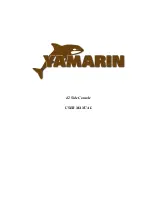
Section 11
HULL/BODY
Sub-Section 02
(ADJUSTMENT AND REPAIR)
11-02-26
SANDING
Begin block sanding the patch with 320-grit sand-
paper until you come close to the original surface.
Remove dust with a water soaked cloth and con-
tinue sanding with a 400-grit wet paper. Finish
wet sanding with a 600-grit to remove deeper
scratches. If needed you can wet sand with finer
grit paper such as 1000-grit.
BUFFING AND WAXING
Buff the surface using a heavy duty polisher with
a buffing pad. Make sure the pad is free of dirt or
you may damage the gelcoat. Carefully begin
buffing with a white medium compound. Finish
off using a fine compound. While buffing, pay
close attention to avoid overheating the surface.
Blisters
Possible Causes:
– Insert catalyst.
– Improper catalyst/gelcoat ratio.
A blister is a visible bump on the watercraft sur-
face that may not necessarily come right through
the gelcoat layer. In the case of only a few blisters,
follow the same repair procedure as for air bub-
bles. If they are numerous and in close concentra-
tion, spray liquid gelcoat to achieve proper repair.
This procedure is covered in
Minor Gelcoat Frac-
tures
.
Minor Gelcoat Fractures
Possible Causes:
– Flexing of fiberglass laminate.
– Gelcoat thickness.
– Direct result of impact.
In case of fractures which have not penetrated
past the gelcoat layer, the repair concerns the
gelcoat only. If flex cracking or impact are evident,
then additional reinforcement may be necessary.
This subject will be covered in Compound Frac-
tures.
PREPARING THE SURFACES
Small Fractures
Open the cracks up with a sharp triangular can
opener or preferably a carbide tipped die grinder.
The V groove will provide a good bonding area for
the gelcoat. With 220-grit sandpaper, sand the
sides of the notched out areas.
Numerous Fractures
Using a grinder with a 24-grit disk, remove the
gelcoat. Sand the area edge with 220-grit sandpa-
per.
FILLING THE REPAIR AREA
Small Fractures
Refer to the same procedure as in the
Air Bub-
bles
.
Numerous Fractures Over Large Surface:
Prepare the area for spray application of liquid
gelcoat. Wipe down the surface with acetone.
Mask the area off to protect the watercraft from
overspray.
Mix the needed quantity of gelcoat and catalyst
according to suppliers recommendations. The
gelcoat can be thinned with acetone up to 10%. If
it needs more consistency you can add cabosil.
Make sure that the air supply is free of oil, dirt and
water.
Test spray the gelcoat mixture on paper to verify
its consistency and pattern. You may have to ap-
ply 5 or 6 coats to cover the area properly. Overlap
each coat further than the last, leaving at least 30
seconds between passes. Avoid trying to coat the
surface with only a few heavy coats, this will not
allow the gelcoat to dry properly.
Apply a coat of polyvinyl alcohol to seal off the air
and protect the gelcoat surface from dust. PVA
speeds up the curing process because gelcoat
will not cure properly when exposed to air.
SANDING
Wash the polyvinyl alcohol off with water. De-
pending on the size of the area repaired, you can
either block sand as per previous procedure or
you may use an air sander. Sand the surface down
with progressively finer grits of sandpaper until
the desired finish is achieved.
BUFFING AND WAXING
Buff the surface using a heavy duty polisher with
a buffing pad. Make sure the pad is free of dirt or
you may damage the gelcoat. Carefully begin
buffing with a white medium compound. Finish
off using a fine compound. While buffing, pay
close attention to avoid overheating the surface.
www.SeaDooManuals.net
Summary of Contents for 1997 GSI
Page 1: ...www SeaDooManuals net ...
Page 2: ...0 0 SHOP MANUAL 0 219 100 048 www SeaDooManuals net ...
Page 343: ...www SeaDooManuals net ...
Page 344: ...www SeaDooManuals net ...
Page 345: ...www SeaDooManuals net ...
Page 346: ...www SeaDooManuals net ...
Page 347: ...www SeaDooManuals net ...
Page 348: ...www SeaDooManuals net ...
Page 349: ...www SeaDooManuals net ...
Page 350: ...www SeaDooManuals net ...
Page 351: ...www SeaDooManuals net ...
Page 352: ...www SeaDooManuals net ...
Page 353: ...www SeaDooManuals net ...
Page 354: ...www SeaDooManuals net ...
Page 355: ...www SeaDooManuals net ...
Page 356: ...www SeaDooManuals net ...
Page 357: ...www SeaDooManuals net ...
Page 358: ...www SeaDooManuals net ...
Page 359: ...www SeaDooManuals net ...
Page 360: ...www SeaDooManuals net ...
Page 361: ...www SeaDooManuals net ...
Page 362: ...www SeaDooManuals net ...
Page 363: ...www SeaDooManuals net ...
Page 364: ...www SeaDooManuals net ...
Page 365: ...www SeaDooManuals net ...
Page 366: ...www SeaDooManuals net ...
Page 367: ...www SeaDooManuals net ...
Page 368: ...www SeaDooManuals net ...
Page 369: ...www SeaDooManuals net ...
Page 370: ...www SeaDooManuals net ...
Page 371: ...www SeaDooManuals net ...
Page 372: ...www SeaDooManuals net ...
















































